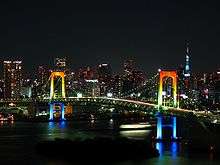Rainbow Bridge (Tokyo)
| Rainbow Bridge レインボーブリッジ | |
|---|---|
 | |
| Coordinates | 35°38′11″N 139°45′49″E / 35.63639°N 139.76361°ECoordinates: 35°38′11″N 139°45′49″E / 35.63639°N 139.76361°E |
| Carries | Vehicle, Yurikamome, Pedestrian |
| Crosses | Tokyo Bay |
| Locale | Minato, Tokyo, Japan |
| Characteristics | |
| Total length | 798 m |
| Width | 49 m |
| Height | 126 m (towers), 52 m (roadway) |
| Longest span | 570 m |
| Number of spans | 3 |
| History | |
| Construction end | 1993 |
| Opened | August 26, 1993 |
The Rainbow Bridge (レインボーブリッジ Reinbō burijji) is a suspension bridge crossing northern Tokyo Bay between Shibaura Pier and the Odaiba waterfront development in Minato, Tokyo, Japan.
It was built by Kawasaki Heavy Industries,[1][2] with construction starting in 1987 and completed in 1993.[3] The bridge is 798 metres (2,618 ft) long with a main span of 580 metres (1,903 ft).[4] Officially called the "Shuto Expressway No. 11 Daiba Route - Port of Tokyo Connector Bridge,"[5] the name "'Rainbow Bridge" was decided by the public.
The towers supporting the bridge are white in color, designed to harmonize with the skyline of central Tokyo seen from Odaiba. There are lamps placed on the wires supporting the bridge, which are illuminated into three different colors, red, white and green every night using solar energy obtained during the day.
The bridge can be accessed by foot from Tamachi Station (JR East) or Shibaura-futō Station (Yurikamome) on the mainland side.
Usage
The Rainbow Bridge carries three transportation lines on two decks. The upper deck carries the Shuto Expressway's Daiba Route, while the lower deck carries the Yurikamome rapid transit system in the centre, walkways on the outer side, and Tokyo Prefectural Route 482 in-between. Route 482 was formerly a tolled road, but opposition to the toll led to its removal. Light motorcycles under 50cc are not permitted on either deck or the walkway of the bridge. Motorcycle pillion passengers are also banned.
Walkway
The bridge has two separate walkways on the north and south sides of the lower deck; the north side offers views of the inner Tokyo harbour and Tokyo Tower, while the south side offers views of Tokyo Bay and occasionally Mount Fuji. The walkways may only be used during certain hours (9 am to 9 pm in the summer; 10 am to 6 pm in the winter, access to the walkways close 30 minutes before closing time.)[6] Bicycles are permitted on the condition that they are pushed (as opposed to riding them). The lower deck also carries a sidewalk that runs along both sides of the roadway.
Panorama

See also
References
- ↑ ArchiTravel - Kawasaki Heavy Industries Retrieved October 4, 2015
- ↑ Structurae - Rainbow Bridge Retrieved October 4, 2015
- ↑ Rainbow Bridge record broken October 6, 2002 Japan Times Retrieved October 4, 2015
- ↑ "首都高速道路株式会社|首都高の名所|レインボーブリッジ". Retrieved 2009-12-26.
- ↑ Japan National Tourist Organization - Rainbow Bridge Retrieved October 4, 2015
- ↑ Tokyo Bureau Of Port and Harbour - Rainbow Bridge Retrieved October 4, 2015 (Japanese)
External links
| Wikimedia Commons has media related to Rainbow Bridge, Tokyo. |
- Rainbow Bridge (Metropolitan Expressway Co., Ltd.) (Japanese)
- Rainbow Bridge at Structurae (English)